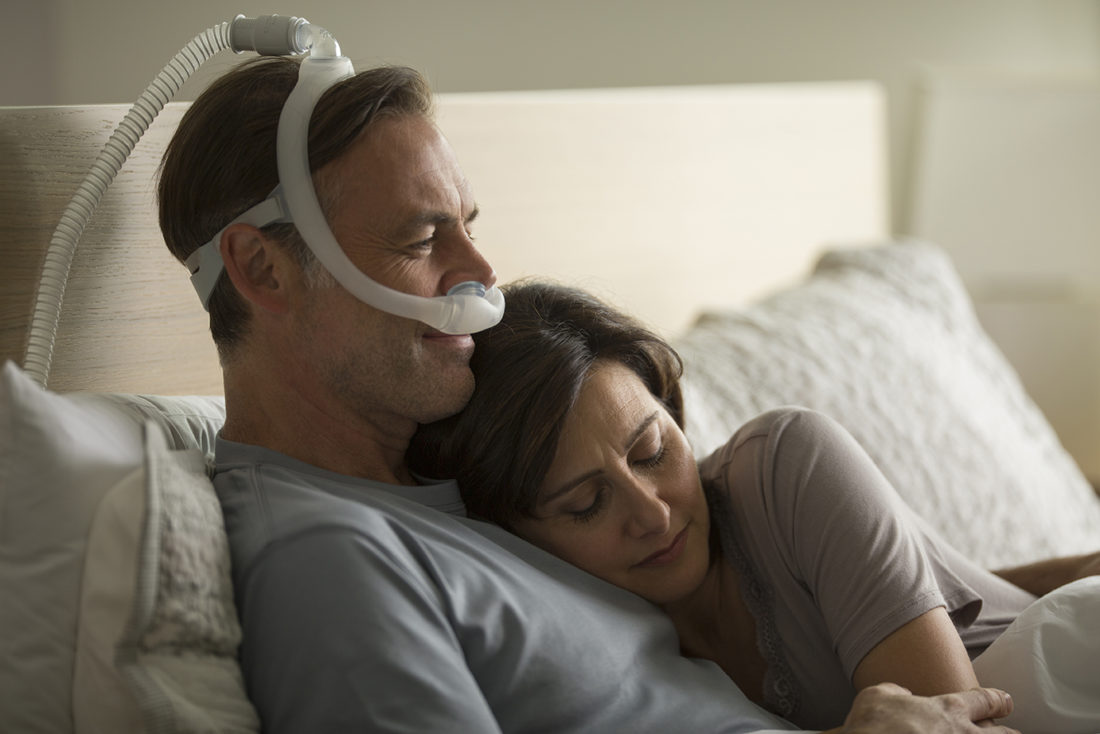Whether you are going to be traveling for the holidays, for work or just to…

Tips for Falling Asleep with Your CPAP

Continuous positive airway pressure therapy, commonly referred to as CPAP, is one of the most commonly used methods to treat obstructive sleep apnea. The CPAP machine delivers a constant stream of pressurized air through a mask. The pressure of the air from the machine is slightly greater than the ambient air, which helps to keep the airway passages open. Unfortunately, only about 60 percent of patients prescribed CPAP therapy are actually compliant. Many patients discontinue use because they find the mask uncomfortable or have difficulty adjusting to the forced air. This can lead to excessive daytime drowsiness, decreased mental alertness and even cardiovascular problems.
Common Complaints from CPAP Users
- Like the majority of medical devices, a CPAP requires an adjustment period. Below are some of the most common CPAP complaints.
- Mask leaks or moves during sleep
- Feels cumbersome and makes it difficult to fall asleep
- Forced air is difficult to tolerate
- Air makes the nose dry and stuffy
- Mask feels claustrophobic
- Mask causes skin irritations and sores – CPAP Cleaning Tips here
- The machine is too noisy
While these issues can certainly be frustrating, it is important to remember that they typically improve with time or with a few simple adjustments to your mask and machine.
Get the Right Mask
There are a wide range of CPAP mask styles to suit different needs, face shapes and sleeping patterns. A full mask covers the mouth and nose and has straps across the cheeks and forehead to hold it securely in place. These masks work well for individuals who tend to move around while sleeping.
If you find that a full mask is too claustrophobic, there are nasal pillow masks available that cover less of your face. This style of mask doesn’t obstruct vision, which makes it ideal for those who enjoy nighttime reading. However, nasal pillow masks can shift out of place if you move a lot during the night or sleep on your side. Masks also come in different sizes that vary from manufacturer to manufacturer. In most cases, the straps can be adjusted to ensure the proper fit.
Practice Wearing Your Mask
Start out by wearing the mask for brief periods during the day to get used to the sensation of it on your face. Once you start to adjust, try wearing it with the pressure on to get used to the sensation of forced air. It may take several weeks, but it should start to feel more natural over time. Special CPAP pillows are also available that accommodate the mask and tubing to make sleeping more comfortable.
If the mask makes you feel claustrophobic, try holding it to your face without any of the tubing. This will help you slowly adjust to the sensation of wearing the mask. Once you’re comfortable with this, hold the mask to your face with the tubing but without the straps. Then, try turning on the machine at a low pressure and using the “ramp” setting to get used to the sensation of forced air. The last step is to add the straps.
Ramp Up the Pressure:
Most CPAP machines come with a “ramp” feature that will start the machine at a low pressure and gradually increase to the prescribed level as you fall asleep. If this doesn’t ease your discomfort, your doctor may be able to prescribe a machine that will automatically increase the pressure as you inhale and decrease it when you exhale, which may be more comfortable.
Add a Humidifier
If your CPAP causes you to wake up with a dry nose and mouth, a heated humidifier that attaches to the machine may help. This is intended to keep the mucous linings of your nose and mouth from drying by keeping the air moist. You can also use a saline nasal spray or decongestant before bed to try to alleviate nasal stuffiness. It is important to talk to your doctor before using a decongestant since they may not be appropriate if you have certain medical conditions, such as high blood pressure.
Preventing Skin Irritations
If properly sized and adjusted, your mask should not leak or cause discomfort. If you notice minor leaking or develop occasional facial sores, nasal pads and mask cushions are available to reduce friction and leaks.
Coping with CPAP Noise
Today’s CPAP machines are virtually noise-free. Any of the audible noises caused by the pressure changes can normally be blocked out with ear plugs or masked by a white noise machine. Excessive noise typically indicates a defect with the machine. Check to make sure the filters are clean and remove anything obstructing the airflow. If this does not work, you should have the machine professionally serviced.
Sleeping without your prescribed CPAP should never be an option. These are medical devices that promote restful sleep in spite of obstructed breathing and our tips should help you better acclimate to it. At Home Sleep Delivered, we understand that comfortability and convenience are the two biggest priorities for most people. That’s why we offer state-of-the-art home sleep apnea testing, CPAP supplies and resupplies so that you’ll never have to leave the house to get ready for bed. Consult your physician or a sleep specialist if you find it difficult to fall asleep with your CPAP – don’t give up on it!


